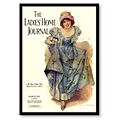Curtis Publishing Company facts for kids
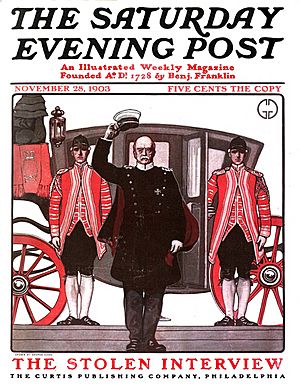
The November 28, 1903 cover of The Saturday Evening Post, a famous magazine from the Curtis Publishing Company.
|
|
| Industry | Publishing |
|---|---|
| Founded | 1891 |
| Founder | Cyrus H. K. Curtis |
| Headquarters |
,
United States
|
| Products | Magazines |
| Services | Advertising |
The Curtis Publishing Company was a major American magazine publisher founded in 1891 in Philadelphia, Pennsylvania. In the early 1900s, it became one of the biggest and most important publishers in the United States.
The company was famous for its popular magazines. These included the Ladies' Home Journal and The Saturday Evening Post. It also published The American Home, Holiday, Jack & Jill, and Country Gentleman.
During the 1940s, Curtis also had a comic book brand called Novelty Press. The company's success faded in the later 20th century. Its magazines were either sold or stopped being published. Today, the company is known as Curtis Licensing. It sells the rights to use classic images and artwork from its old magazine covers.
Contents
History of a Publishing Giant
Getting Started in the 1800s
The Curtis Publishing Company was started in 1891 by Cyrus H. K. Curtis. He had already launched a news magazine called People's Ledger in Boston in 1872. In 1876, he moved to Philadelphia, which was a major center for publishing.
In 1879, Curtis created a new magazine called Tribune and Farmer. His wife, Louisa Knapp Curtis, added a special section just for women. This section grew into its own magazine, the Ladies' Home Journal, in 1883. It became very successful.
In 1897, Curtis made a big move. He bought The Saturday Evening Post for only $1,000. He turned it into one of the most popular magazines in the country.
The Golden Age: Early 1900s
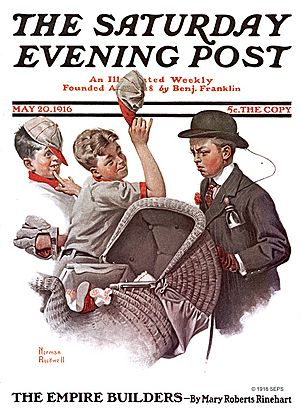
The Saturday Evening Post had roots going all the way back to Benjamin Franklin's Pennsylvania Gazette from 1728. When Curtis bought the Post, it had only 2,000 subscribers. By 1906, it had over a million. By 1960, it had more than six million!
The editor, George Horace Lorimer, hired the best writers and artists. This helped start what is known as the "Golden Age of American Illustration." Famous artists like Norman Rockwell created many of the magazine's iconic covers. Other well-known artists included J. C. Leyendecker and Sarah Stilwell-Weber.
In 1911, Curtis Publishing started one of the first-ever market research departments. Market research is the study of what customers want to buy. This helped the company understand its readers and sell more ads.
Facing New Challenges
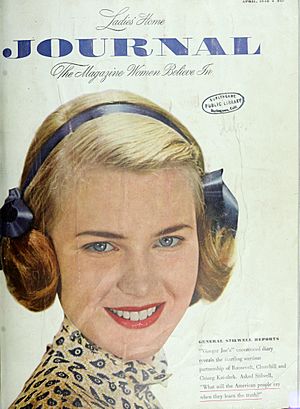
After World War II, a new invention changed everything: television. As TVs became popular in the late 1940s and 1950s, people spent less time reading magazines. This hurt the popularity of magazines like the Post and the Journal.
By the 1960s, the company was in trouble. For the first time in over 70 years, Curtis Publishing started losing money. In 1961, it lost over $4 million. The next year, it lost almost $19 million.
Experts said the company had several problems.
- It had not expanded into new areas like television or book publishing, as its competitors had.
- Its main magazines, the Post and the Journal, were seen as old-fashioned. They were not attracting the younger readers that advertisers wanted to reach.
- The company owned its own paper mills and printing presses. This was expensive to run when business was slow.
To try and save the company, the editors of the Post and Journal were replaced. The Post tried to attract new readers with more modern articles and designs.
The End of an Era
Despite efforts to save it, the company continued to struggle. In 1968, Curtis sold the Ladies' Home Journal and The American Home to another company. It also sold its list of Post subscribers to Life magazine.
The company even sold its headquarters building in Philadelphia to raise money. But it wasn't enough. Curtis Publishing could not find a buyer for The Saturday Evening Post. In 1969, the famous magazine was shut down after more than 140 years of publication.
Curtis Publishing Today
In 1976, a new group called The Saturday Evening Post Society was formed. It brought back The Saturday Evening Post, which is still published today.
The original Curtis Publishing Company now operates as Curtis Licensing. It manages a huge archive of 4,000 images from over 500 artists who worked for its magazines. Companies can buy the rights to use these images on products like art prints, greeting cards, and other collectibles. The Norman Rockwell cover paintings are especially popular.
The Famous Curtis Building
| Curtis Publishing Company | |
|---|---|
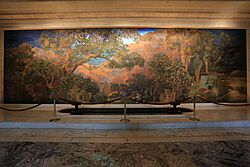
Dream Garden is a huge mosaic made of glass. It was designed by Maxfield Parrish and created by Louis Comfort Tiffany.
|
|
| Location | 170 S. Independence Mall West, Philadelphia, Pennsylvania, U.S. |
|
Philadelphia Register of Historic Places
|
|
| Designated | November 30, 1998 |
In 1910, the company built its headquarters in Philadelphia, very close to Independence Hall. The large, beautiful building was designed in the Beaux Arts style.
Inside the building's lobby is a famous work of art called Dream Garden. It is a giant glass mosaic, measuring 15 feet tall and 49 feet wide. It was designed by artist Maxfield Parrish and made by the world-famous Louis Comfort Tiffany and his studio in 1916. The mosaic is made of over 100,000 pieces of special Favrile glass in 260 different colors.
In 1998, a casino owner bought the mosaic and planned to move it to Las Vegas. But art lovers and historians in Philadelphia raised $3.5 million to buy it back. They wanted to make sure the artwork stayed in the city. Today, the Pennsylvania Academy of the Fine Arts owns Dream Garden, and it remains in the Curtis Center for everyone to see.
Famous Magazines
- The Saturday Evening Post
- Ladies' Home Journal
- The American Home
- Holiday
- Jack & Jill
- The Country Gentleman
- Novelty Press (comic books)
See also
- Curtis Hall Arboretum, the Curtis family's former home in Wyncote, Pennsylvania
Images for kids
-
Ladies' Home Journal in 1900.



